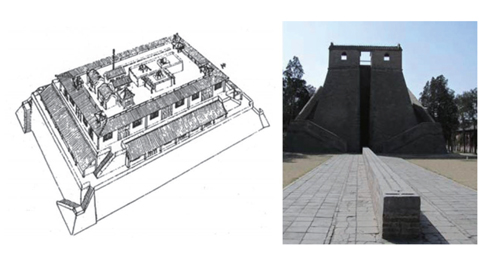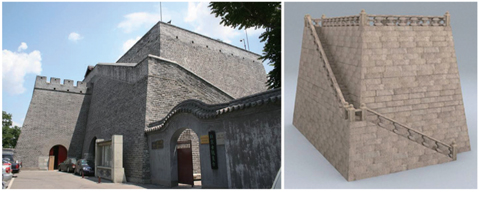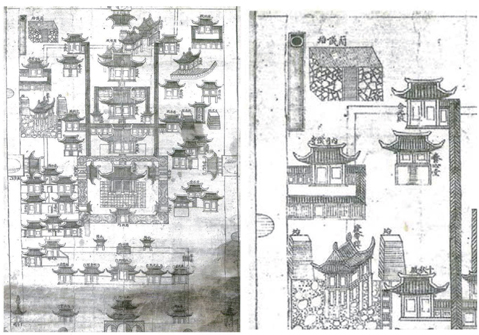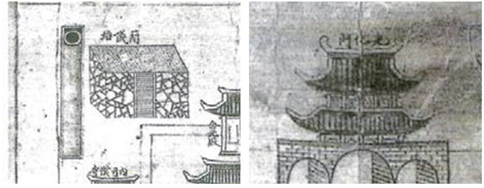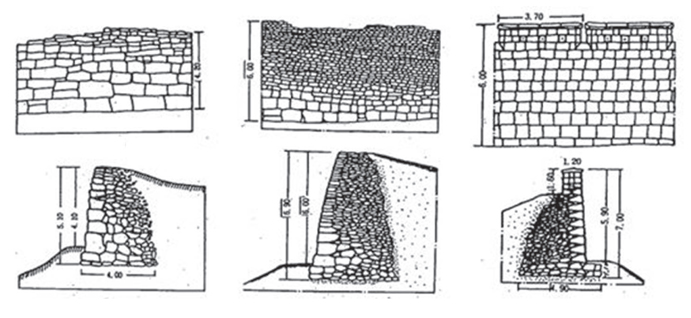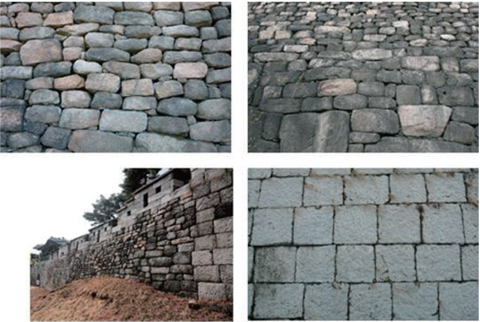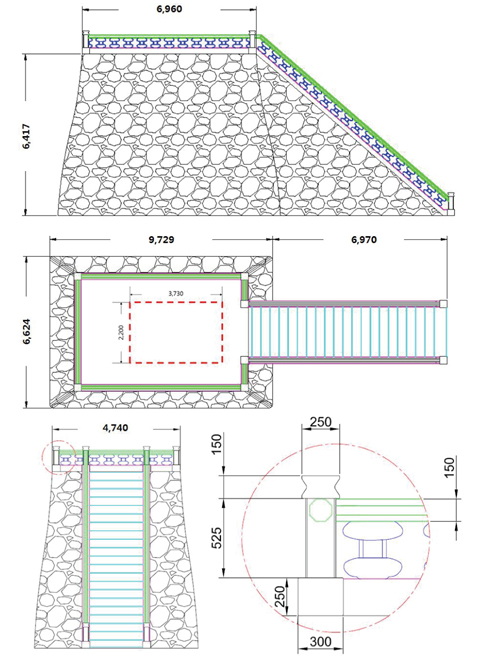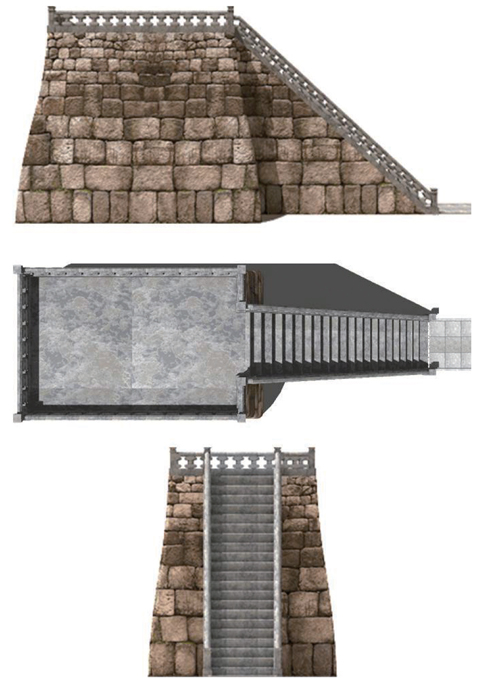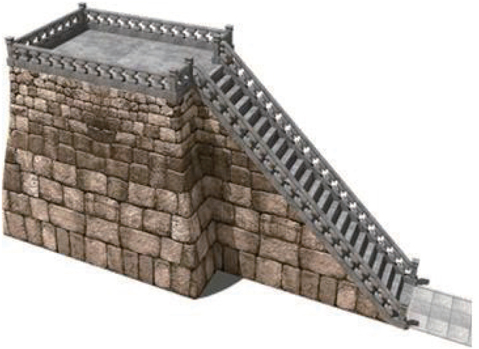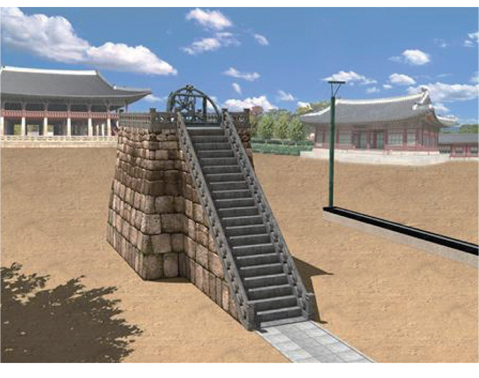King Sejong (世宗) of Joseon Daynasty (朝鮮時代) made a remarkable astronomical achievements in the Korean history(Jeon 1994, Nam 2002, Nha 2006). Making various astronomical instruments such as Ganui (簡儀) in this period influenced the making of 『Chiljeongsan Naeoepyeon(七政算內外篇)』 and national time system. Thus, Ganui and Ganui-Dae (簡儀臺, 1432~33) were the main astronomical projects. The Ganui-Dae is not just a support (臺) that the Ganui is constructed on. It is comprehensive observatory with the various instruments for observation and time signal (時報) such as Ganui, Gyupyo, Water-hammering type Honui, Honsang, and so on (Nam 2002).
Historically, various world powers (列强) bui l t astronomical observation facilities in large scale and devoted to their scientific techniques. For example, Ulugh Beg Observatory (1424~1429) was built what is current day Samarkand, Uzbekistan in Timurid Dynasty. Also, Guanxing-tai (觀星臺, current day 古觀象臺, 1442) was built in Beijing (北京), China, in Ming Dynasty (明代), and Greenwich Observatory (Royal Observatory, Greenwich, 1675) was built in Greenwich, England. These observatories represent each country's history of scientific techniques and come into the spotlight as important tourism resources. Ganui-Dae is the comprehensive observatory that can stand comparison with the listed observatories above, and it can perform the same function (Kim et al. 2011). However, Ganui-Dae doesn't exist. Even though its restoration is needed, its exact external form isn't suggested.
Until now, major studying on Ganui-Dae was its location, history and construction criterion and so on (Jeon 1964, Lee 1996, Nha 1997, Nam 2008, Chung 2010, Mihn et al. 2010, Kim et al. 2011). On the contrary, few studying on external form and construction method of Ganui-Dae is performed. Some suggested models of Ganui-Dae (such as model of culturecontent.com of Korea Creative Contents Agency (KCCA)) cannot suggest exact basis of external form and construction method etc.
This study analyzes the external form of Ganui-Dae in the antique maps and suggests new restoration model based on the analysis of construction method.
In the previous studies, Sitian-tai (司天臺, 1279), built in the Beijing during the Yuan Daynasty (元代), is believed that it influenced on Ganui-Dae (Kim et al. 2011, Fig. 1). There are several basis that the Sitian-tai influenced the construction of Ganui-Dae. The first basis is ‘Ganuidaegi (簡儀臺記)' in 『Sejong Sillok (世宗實錄)』. It is direct record of the construction of Ganui-Dae. It also said that method to make various instruments like Ganui follows 『Yuanshi (元史)』 in the Ganuidaegi1 . The second basis is 『Yeonryeosilgisul (練藜室記述)』 written by Lee Gung-ik (李肯翊) in the late Joseon Dynasty. The record of the 『Yeonryeosilgisul』 said that the King Sejong ordered Jang Young-sil (蔣英實) et al. to go to China and to learn the construction techniques of astronomical instruments in 1421. It also said that the King Sejong made them who came back in following year (1422) participate in constructing astronomical instruments.2
However, it is hard to believe that Sitian-tai is the original form of Ganui-Dae. It is because there is no direct describes about Ganui-Dae in the Ganuidaegi. Furthermore, there is a possibility of loss of Sitian-tai in the middle period of visit of Jang Young-sil et al. This is specified in 『Yeonryeosilgisul』. The possibility of loss of Sitian-tai is based on the construction of another observatory, Guanxing-tai (觀星臺, current day 古觀象臺), is built on Beijing in 1442, Ming Dynasty (Kim et al. 2011). Construction of Guanxing-tai can be considered as a replacement of lost Sitian-tai. As a result, the year of 1442, when the Guanxing-tai was constructed, is middle period of visit of Jang Young-sil et al, so there is a quite possibility of loss of Sitian-tai. This implies that the Sitian-tai cannot be the original form of Ganui-Dae's external form.
Another observatory, Dengfeng (登封) Guanxing-tai (觀星臺, 1279, Fig. 1), is constructed in Yuan Dynasty (Kim et al. 2011). However, there is no record of installation of instruments like Honchunui, so it is guessed that the company of Jang Young-sil wouldn’t visit the Dengfeng Guanxing-tai.
'Culturecontent.com' of KCCA suggested the 3D model of Ganui-Dae. It seems to be based on the Guanxing-tai in Ming Dynasty3 (Fig. 2). However, as mentioned above, it is hard to consider that the Guanxing-tai, constructed in Ming Dynasty, is the external form of Ganui-Dae, because Guanxing-tai was constructed after the visit of Jang Young-sil company.
To synthesize the content above, both Sitian-tai in Yuan Dynasty and Guanxing-tai in Ming Dynasty in Beijing were hard to be the original form of Ganui-Dae. Therefore, the new external form model of Ganui-Dae is needed.
There are some old maps (古地圖) which shows the original appearance of Gyeongbokgung palace. Moreover, the maps which show Ganui-Dae are 『Gyeongbokgung- Do (景福宮圖)』 in the National Folk Museum of Korea, 『Gyeongbokgungjun-Do (景福宮全圖)』 in Samsung Museum of Publishing, 『Doseong-Do (都城圖)』 in Kyujanggak(奎章閣) Institute For Korean Studies, and 『Gyeongbokgung-Do (景福宮圖)』 in Sotheby's and so on.
Among these maps, 『Gyeongbokgungjun-Do』 in Samsung Museum of Publishing only shows the name of Ganui- Dae, and 『Gyeongbokgungjun-Do』 in Samsung Museum of Publishing and 『Doseong-Do』 in Kyujanggak Institute For Korean Studies show unclear shape of Ganui-Dae with the name. Therefore, it is hard to use for studying of external form of Ganui-Dae (Fig. 3).
『Gyeongbokgung-Do』 in Sotheby's was known by being auctioned in Sotheby's on New York in 1997. It is valuable material which shows the appearance of Gyeongbokgung Palace before the loss, caused by two wars. This Gyeongbokgung-Do guessed that it made in the reign of King Youngjo (1742~1776), late period of 18 century. Different from other Gyeongbokgung-Do, it is reliable that it shows the location and description of royal palace clearly (Lee 2004). On the left side of Ganui-Dae on 『Gyeongbokgung- Do』 in Sotheby's, Gyupyo is described clearly, and stairs and construction method4 can be identified in the map (Fig. 4 right picture).
In the 『Gyeongbokgung-Do』in Sotheby's, there is need to focus on the external form of Ganui-Dae. As comparing the Ganui-Dae in 『Gyeongbokgung-Do』 in Sotheby's with Gwanghwamun (光化門), the gate under the royal palace of Gwanghwamun looks like a building, built with the well-faced stone. However, Ganui-Dae looks like structure with a form of embankment or rampart, built with not-faced stone (Fig. 5). Ganui-Dae model of culturcontent.com of KCCA has the form of construction with well-faced stone. If 『Gyeongbokgung-Do』 in Sotheby's is believed, the model would be wrong.
There is another appreciable thing in the 『Gyeongbokgung-Do』 in Sotheby's. It is that the stairs, in front of Ganui-Dae, were straight. The Beijing Ancient Observatory in Beijing, which culturecontent.com of KCCA used as the original form of Ganui-Dae, has winding stairs, not the straight. Comparing with straight stairs of 『Gyeongbokgung-Do』 in Sotheby's, Ganui-Dae model of culturecontent.com of KCCA is wrong.
Considering of the reliability of 『Gyeongbokgung- Do』 of Sotheby's (Lee 2004), external form of Ganui- Dae needs suggestion of new model in the form of construction. Moreover, study on the construction method of embankment or rampart in the reign of the King Sejong is also needed.
There is a purpose of establishment of Ganui-Dae, described in 『Sejong Sillok』 as follows;
The 19th Year of King Sejong (1437) April 15th (甲戌)
There was first made using wood. Use it was determined that the north pole is 38 degree from the ground. This is almost to the 《Yuanshi (元史)》. Finally Ganui made of copper was completed. Give instructions to Hojo-panseo (戶曹判書) Ahn-Soon. A platform of 31 cheok high and 47 cheok long, 32 cheok width was built around the northern part of Gyeonghoeru. Placed on the platform were Ganui. Jeongbangan is placed in the south. And, Dongpyo in height of 8 cheok and height has five times from platform placed on the west side of the platform.
In this record, King Sejong assigned Ahn-Soon (安純)5, Hojo-panseo (戶曹判書), for the construction of Ganui- Dae. This suggests very important fact. According to 『Sejong Sillok』, Ahn-soon was in charge of removal of Gyeongwon-Sung (慶源城) before construction of Ganui- Dae in 1432. At that time, King Sejong ordered Hwang- Hee (黃喜), Younguijeong (領議政), to remove Gyeongwon-Sung, and Hwang-Hee recommended Ahn-soon 6. This suggests that Ahn-soon had construction knowledge about a castellation. It is connected with that Ganui-Dae, shown in『Gyeongbokgung-Do』of Sotheby's, has form of castellation.
A study on the castellation method rose from 『Gyeongbokgung-Do』 of Sotheby's and the case of Ahn-soon proceeded with the Seoul Fortress. Seoul Fortress is suitable for studying because it shows the chronological changes of construction method in Joseon Dynasty (Culture Haritage Administration of Korea, shortly CHAOK 2001).
Seen in Fig. 6, ramparts were built with the various sizes of well-faced natural stones in the reign of King Taejo. Compared with the reign, more faced rectangular (長方形) stones were used at the construction. In the reign of King Sukjong, ramparts were built with standardized square (正方形) stones.
Differences were identified in the real figure of Seoul Fortress in Fig. 7. Therefore, the model of Ganui-Dae which would be suggested should follow the construction method in the reign of King Sejong.
Historically, Sitian-tai in Yuan Dynasty and Guanxing-tai in Ming Dynasty were hard to be the original form of Ganui-Dae, considering that visiting time of Jang Young-sil company was not matched with their loss and construction. The external form of Ganui-Dae shown in 『Gyeongbokgung-Do』 in Sotheby's has different construction form from existing models. Lastly, through the survey of the past of Ahn-Soon, the construction director of Ganui-Dae, the construction form of Ganui-Dae was the form of castellation.
These three facts emphasize that the new external form model of Ganui-Dae is needed. In the study, Seoul Fortress in Mt. Bukaksan was surveyed to make new external model of Ganui-Dae. The study also suggests the model of Ganui-Dae by using the castellation method in the reign of King Sejong.
In the new model of Ganui-Dae, its size follows the 『Sejong Sillok』7 and scale used at construction was Ju-Cheok (周尺), not Youngjo-Cheok (營造尺). The location of the stairs were settled on the north (Kim et al. 2011). Their sizes follows ones of Geunjeongjeon of Gyeongbokgung palace, because there is no statement about sizes in the document. The handrail of Ganui-Dae also follows Geunjeongjeon's one because of no statement in document.
Scales of Ganui-Dae in 『Sejong Sillok』 were 31 cheok of height, 47 cheok of length, and 32 cheok of width8 . In Joseon Dynasty, it was common that Youngjo-Cheok was used for the building and Ju-Cheok was used for various instruments (Nam 1995). Exact scale, used for Ganui-Dae, was not known, but using of Ju-Cheok at the construction of Ganui-Dae was inferred through the content in『Seongjong Sillok (成宗實錄)』; only Gyupyo is seen, but Ganui-Dae isn't to be seen (Kim et al. 2011).
As the scales of Ganui-Dae converted Ju-Cheok (1 cheok = 207 mm; Nam 1995) to the present metric system, height is 6,417 mm, length is 9,729 mm, and the width is 6,624 mm. The part of Seoul Fortress in the reign of King Sejong was referred on the overall external form of Ganui-Dae. Fig. 8 is the drawings of Ganui-Dae which based on results of this study.
Based on the drawing of Ganui-Dae, 3D modeling was performed. The external wall of Ganui-Dae was mapped with the source of exterior of Seoul Fortress. Stairs and handrail were mapped with the source of stairs and handrail of Geunieongjeon in Gyeongbokgung palace (Fig. 9). Aerial view of 3D modeling of Ganui-Dae, which synthesizes these contents, is in the Fig. 10.
Fig. 11 is an impression, which considers the environment in the reign of King Sejong. Gyupyo is placed on the left side of Ganui-Dae. Gyeonghoeru (慶會樓) is placed on the south of Ganui-Dae based on the Sillok, saying that Ganui-Dae was located on the north of Gyeonghoeru. The building, seen on the left side of Gyupyo is Honuihonsanggak (渾儀 渾象閣). In the building, Water-hammering type Honui and Honsang were installed.
Ganui-Dae, constructed in the reign of King Sejong, has historical meaning of scientific technique as the comprehensive observatory which shows techniques at that time. It is also available resource as a scientific tourism resource. Therefore, the restoration of Ganui-Dae is urgent. However, comparing with the importance, study on the external form of Ganui-Dae is insufficient. Focused on it, this study tried to approach to the external form and construction method of Ganui-Dae. And then, based on the new approach, the study suggested the new external model of Ganui-Dae.
Historically, Sitian-tai in Yuan Dynasty (1279) has possibility of loss, and Guanxing-tai in Ming Dynasty (1442) were constructed after visiting of Jang Young-sil company (1421~1422). Therefore, both Sitian-tai and Guanxing-tai were not suitable to make them as the origin of Ganui-Dae for Jang Young-sil company.
Many old maps used for the study of Ganui-Dae shows only name or simple external form, so it is hard to be used for the study of external form of Ganui-Dae. Otherwise, exact location and description of royal palaces were marked in 『Gyeongbokgung-Do』in Sotheby's in details. Therefore, its material and external form of Ganui-Dae, described on the map, were reliable. Ganui-Dae described on the『Gyeongbokgung-Do』in Sotheby's was similar to construction with the form of a castle, not the form of building. Also, straight stairs in the front were verified.
By surveying of the past of Ahn-Soon, Hojo-panseo who was the construction director of Ganui-Dae, he was a person who participated in the construction and removal of the castle before the construction of Ganui-Dae. This is connected with the Ganui-Dae, which has form of castle described in the 『Gyeongbokgung-Do』in Sotheby's.
Under the supposition that Ganui-Dae has form of castle, the castellation method in the reign of King Sejong was analyzed. In the result of the survey of Seoul Fortress, which shows the castellation method in the reign of King Sejong, the ramparts in the reign were made with well-faced rectangular stones. The big ones were used at the down side and the small ones were used at the upper side. It is different from existing model of Ganui-Dae, which used standardized stones or bricks.
This study suggested the new model of Ganui-Dae with the basis of construction applied the method in the reign of King Sejong. To use new model for real restoration, drawing was made and 3D modeling was performed based on the drawing. With the new external model of Ganui-Dae, restoration of Ganui, the Korean representative observatory, and instillation of pride toward Korean scientific techniques were expected. Also, it is expected to utilize it as tourism resource for foreign people.




